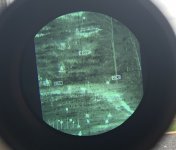What I don't understand about the pixel IN has to equal the pixel OUT theory is that it depends on where the thermal is aimed that determines what that pixel IN represents. Using that theory, once the Yoter was calibrated so the pixels in and pixels out were aligned, you should be able to swap it between rifles or have a mount that shifts without it affecting the POI. I can assure you that you can't, and the error is large. Think 6" at 100yds large. If every rifles rails were perfectly aligned, maybe it would work, but it only takes a .003" deviation over a 6" long rail to change the POI 2"@100yds. The typical Badger EFR isn't installed anywhere close to those tolerances.
I tried to draw an example. Everything is happy in the first 2 examples. The thermal is perfectly aimed at the target and CPI (center pixel in) transfers that target to the CPO (center pixel out) and the cross hair is aligned with that pixel so our POI is good. But as soon as the thermal is shifted angularly in regards to our rifle system, (remember how little it takes to cause a 2" error @100yds?) the cross hair stays reasonably aligned with the CPO, but now the CPI is aimed at some point other than the target. Now the rifle is moved until the CPI is back on the target and our POI moves with it.
I'm not trying to argue, I'm just trying to understand it. If somebody can point out the flaw in my reasoning, I'd love to discuss it.

I tried to draw an example. Everything is happy in the first 2 examples. The thermal is perfectly aimed at the target and CPI (center pixel in) transfers that target to the CPO (center pixel out) and the cross hair is aligned with that pixel so our POI is good. But as soon as the thermal is shifted angularly in regards to our rifle system, (remember how little it takes to cause a 2" error @100yds?) the cross hair stays reasonably aligned with the CPO, but now the CPI is aimed at some point other than the target. Now the rifle is moved until the CPI is back on the target and our POI moves with it.
I'm not trying to argue, I'm just trying to understand it. If somebody can point out the flaw in my reasoning, I'd love to discuss it.


